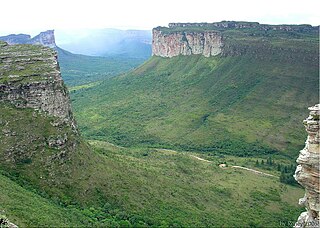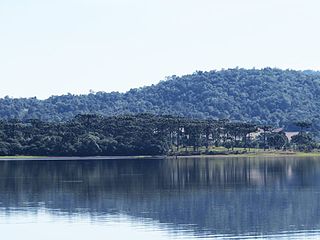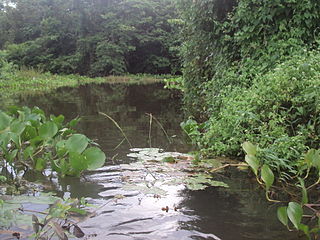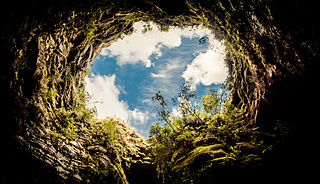Environment
Altitudes range from 650 to 1,525 metres (2,133 to 5,003 ft). The park is in the Serras do Espinhaço Meridional. It forms part of the watershed between the Jequitinhonha River and São Francisco River, which it feeds from about 600 springs. Average annual rainfall is 1,200 millimetres (47 in). Temperatures range from 5 to 32 °C (41 to 90 °F) with an average of 20 °C (68 °F).
The park has well-preserved examples of varied types of vegetation including cerrado woodland and fields, seasonal semi-deciduous forest, swamp forest, streams, lagoons and riparian vegetation. These support a wide range of plant species. There are four endemic species of amphibians: Bokermannohyla saxicola, Lanceback Treefrog (Scinax curicica), Pseudopaludicola mineira and Thoropa megatympanum. There are two endemic bird species: hyacinth visorbearer (Augastes scutatus) and grey-backed tachuri (Polystictus superciliaris).

The Jaú National Park is a national park located in the state of Amazonas, Brazil. It is one of the largest forest reserve in South America, and part of a World Heritage Site.

The Chapada Diamantina National Park is a national park in the Chapada Diamantina region of the State of Bahia, Brazil. The terrain is rugged, and mainly covered by flora of the Caatinga biome.

The Grande Sertão Veredas National Park is a national park located on the border between the states of Minas Gerais and Bahia, Brazil.

The Serra do Cipó National Park is a national park in the state of Minas Gerais, Brazil.

Serra da Canastra National Park is a national park in the Canastra Mountains of the state of Minas Gerais, Brazil.

Araucárias National Park is a national park in the state of Santa Catarina, Brazil.

Pacaás Novos National Park is a national park in the state of Rondônia, Brazil. The park contains a mountain range by the same name.

The Pantanal Matogrossense National Park is a national park in the states of Mato Grosso and Mato Grosso do Sul, Brazil.

Serra Geral National Park is a national park in the states of Rio Grande do Sul and Santa Catarina, Brazil.

Campos Gerais National Park is a national park in the state of Paraná, Brazil.

The Serra do Pardo National Park is a National park in the state of Pará, Brazil.

Chapada das Mesas National Park is a national park in the state of Maranhão, Brazil. It was created to preserve the untouched cerrado vegetation of the region, and as a barrier against the advance of farming.

Nascentes do Rio Parnaíba National Park is a national park of Brazil.

Serra da Bodoquena National Park is a national park in the state of Mato Grosso do Sul, Brazil.

Pirapitinga Ecological Station is an ecological station in Brazil, on an island in the lake formed by the Três Marias Dam in Minas Gerais.

Carste de Lagoa Santa Environmental Protection Area (Portuguese: Área de Proteção Ambiental Carste de Lagoa Santa is a protected area in Minas Gerais, Brazil.

The Serra das Confusões National Park is a national park in the state of Piauí, Brazil.

Boa Nova National Park is a national park in the state of Bahia, Brazil.

Serra do Gandarela National Park is a national park in the state of Minas Gerais, Brazil. It protects a mountainous region holding a remnant of Atlantic Forest that is an important source of water for the city of Belo Horizonte.

The Rio Preto State Park is a state park in the state of Minas Gerais, Brazil. It protects a mountainous area of cerrado vegetation that is home to various endemic, rare or endangered species. Trails provide environmental interpretation, and lead to lookouts that give panoramic views, to rivers and waterfalls, and to archaeological sites with rock paintings.
This page is based on this
Wikipedia article Text is available under the
CC BY-SA 4.0 license; additional terms may apply.
Images, videos and audio are available under their respective licenses.

















